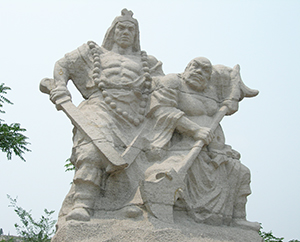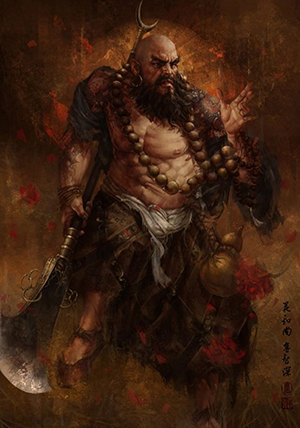|
|

Nimen Hao and Summer Greetings, Shao-Lin,Sr ElderMaster Sharon and I are looking forward to hosting you next month, here in Colorado, for the exciting and classical Lu Da’s Famous Monk Spade Festival on Sunday August 9th, 2020. It is such an exceptional weapon and seminar. You're really going to enjoy it. Be sure to purchase your Monk’s Spade from your instructor, while supplies last… Below is a brief history of one of China’s “18 Classical Weapons” – the Famous & Rare Monk Spade. Safe travels, zai jian, David
Co-Owner/Instructor Attached is the FLYER for the Festival, along with the Backside, with the Black Belt PreTest & the Brown Belt Test info, along with Hotels and Restaurants. click here for Lu Da’s Famous Monk Spade flyer |

Lu Da's SpadeBrief History of the Monk’s SpadeBy Senior Elder Master Sharon Soard 7.15.2020 The spade or shovel is an ancient invention having been around since the stone age. This tool was devised from attaching a sharp edged stone to a long staff. Its early origins were mostly for farming but it proved to be a useful weapon too. Emperor Yu of the Xia Dynasty (2205-1766 BC) was famous for his martial skill with the stone head shovel. His weapon was called the Golden Bell Shovel (Jin Zhong Chan) due to its shape and sheer strength. In the Shang Dynasty (1766-122 BC) the spade began to be constructed of brass making it sharper and more uniform in design and weight. During the Warring Staters Period (403-222 BC) the spade was made of iron which held a much sharper edge making it truly a formidable weapon. It was during this period that the shovel became widely used in combat. This is also when the Crescent Moon (Yue Ya Chan) design came into existence. Up until now, the spade did not have the metal crescent at the other end. Instead it usually had a metal tip. The Han Dynasty (206 BC-25 AD) saw the influence of Buddhism coming into China from India. The Convenient Shovel (Fang Bian Chan) became a tool for the monks during this time as it was the staple tool of farms. Since this period in China saw much war and famine there were always bodies that needed to be buried. This responsibility fell to the monks who would bury the dead and give them their last rites. Later on the monks would carry the Crescent Moon Spade. Since dead bodies would draw animals the monks started using the Crescent Moon Spade with the crescent unsharpened. They would use the crescent to push away the hungry animals so that they could begin the burial. The 3 curves on the blade of the Convenient Spade represent the Buddhist and Taoist principals of Earth, Heaven and Man as well as our Essence, Chi and Spirit. On the Crescent Moon Spade the blade represents the Sun Rising Between Heaven and Earth and the Moon at the other end. This represents the universal balance of Yang and Yin. As time passed the use of the Crescent Moon Spade died out as a military weapon and it became exclusively a monks weapon. Its use by monks continued until the end of the Qing Dynasty (1644-1911 AD). In Chinese history there are two famous individuals who carried a monks spade. One was Sha Wujing from the tales contained in the classic novel Journey to the West. Monk Sha had been a Buddhist monk who became known as The General Who Lifts the Curtain. He protected those looking to find the scriptures. Through his devotion and divine spirit that was said to have been with him since birth, he ascended into heaven. Unfortunately in heaven during a feast of all of the generals at the Jade Pool, Monk Sha broke some of the jade and crystal. For this he was thrown out of heaven and punished by being turned into an ogre who had to fend for himself in the Flowing Sands River. In the tale, Monkey King and his small band needed to cross the river and are challenged by the ogre. Pig aided by Monkey on the side fight the ogre to a draw. A short time later, Monkey King finds out who the ogre really is and befriends him. The ogre becomes known as Friar Sand and carries the monks spade to guard the Tang Priest as they all journey to find the scriptures. The second individual who carried a monks spade was Lu Da - the 13th of the 108 heroes from the classic Chinese novel Outlaws of the Marsh. Lu Da along with the famous Wu Song, were two of only 27 of the 108 heroes who survived the rebellions. Lu began as a low level official who always seemed to get into trouble. He got into a fight with a butcher who was forcing a young woman to marry him. He struck the man 3 times accidentally killing him. He fled to the Buddhist temple at Wutai mountain where the abbot allowed him to become a monk. The abbot gave him the name Zhi Shen, meaning “deep wisdom” in hopes that the Buddha’s wisdom could help to cultivate goodness within Lu Da. We also know Lu Da as Sagacious Lu - meaning of sound judgement and as the Flower Monk or Friar Hua because of his flowery tattooed back. As a monk and being an unusually large and strong man, Lu carried an 80 pound monk’s spade! Lu Zhi Shen unfortunately broke all of the Buddhist rules and in a drunken rage smashed the temple pavilion breaking the Buddha statues. He was banished to another temple to cultivate the temples vegetable garden. It was at this new temple that he subdued 23 robbers and in a show of strength uprooted a tall willow tree with is bare hands. After this show of courage and strength, Lu Zhi Shen met General Lin Chong, the instructor of 800,00 imperial guards. The two became sworn brothers. Another sworn brother to Lu was Zhou Tong, teacher of Wu Song and General Yueh Fei. Later, Lin Chong gets framed by corrupt officials and is sent into exile. The guards try to kill him in Wild Boar Forest but he is saved by Lu Zhi Shen. While on the run after saving Lin Chong, Lu ends up in a famous battle at Twin Dragon Mountain. Afterwards, he joins the outlaws whose decree is “reclaiming justice under heaven”. They band together at Liang Mountain. At the end of his life after capturing a rebel leader, Lu goes to Hangzhou. On the 18th day of the 8th lunar month, a tidal bore of waves always crash upon the banks of the Qingtang River. Lu Zhi Shen is awakened from his sleep by the thundering sound of the waves. In that moment he remembers the poem given to him by the abbot of the Wutai Temple. The last two lines of the poem tell him that his death is eminent now that he has heard the tide. With the awareness of his impending death, Lu composes a poem that tells of his understanding of the meaning of his life. The poem showed that even though he had never read the scriptures when he was a monk, he had the realization that comes with enlightenment. Lu Zhi Shen was buried with priestly honors in Hangzhou, the beautiful city by the West Lake. This city is also the burial home of General Yueh Fei. Marco Polo called Hangzhou “heaven on earth” and it truly is a heavenly resting place for these two heroes. |
